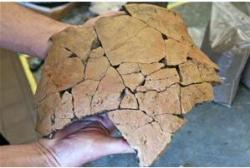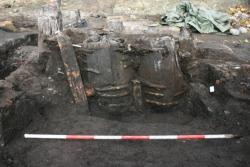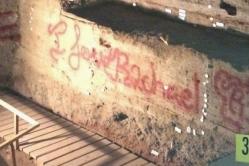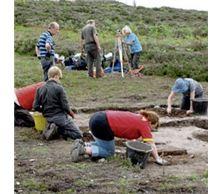INSTITUT SUPERIEUR D'ANTHROPOLOGIE
INSTITUTE OF ANTHROPOLOGY
ONLINE COURSES / COURS A DISTANCE
SPRING TERM : APRIL 2014
REGISTER NOW
POLOGNE –  Motylewo - Archaeologists discovered the remains of the Lusatian culture settlement during studies in Motylewo near Gorzów Wielkopolski. Valuable discovery are two pottery kilns containing vessels, whose age is estimated at about 3 thousand years."The uniqueness of these kilns lies in the fact that inside the firing chambers we have found several already fired vessels" - told PAP Paweł Kaźmierczak from the Lubusz Museum in Gorzów Wielkopolski. To date, archaeologists on site have recorded forty other archaeological objects remaining after the prehistoric settlement, among them the remains of surface structures, storage pits and hearths. Several thousand pieces of pottery were dug up during the study. Scientists are currently working on gluing the vessels back together. Among them is a large storage vessel ornamented with plastic strip. The remaining dozen vessels are slightly smaller. "Several vessels were burnt probably during unsuccessful firing, and perhaps because of their deformation and surface burnt in fire the Lusatian potter left his treasures in the ground" - added Kaźmierczak. The vessels found in kilns will be added to the collection of the Lubusz Museum in Gorzów Wielkopolski.
Motylewo - Archaeologists discovered the remains of the Lusatian culture settlement during studies in Motylewo near Gorzów Wielkopolski. Valuable discovery are two pottery kilns containing vessels, whose age is estimated at about 3 thousand years."The uniqueness of these kilns lies in the fact that inside the firing chambers we have found several already fired vessels" - told PAP Paweł Kaźmierczak from the Lubusz Museum in Gorzów Wielkopolski. To date, archaeologists on site have recorded forty other archaeological objects remaining after the prehistoric settlement, among them the remains of surface structures, storage pits and hearths. Several thousand pieces of pottery were dug up during the study. Scientists are currently working on gluing the vessels back together. Among them is a large storage vessel ornamented with plastic strip. The remaining dozen vessels are slightly smaller. "Several vessels were burnt probably during unsuccessful firing, and perhaps because of their deformation and surface burnt in fire the Lusatian potter left his treasures in the ground" - added Kaźmierczak. The vessels found in kilns will be added to the collection of the Lubusz Museum in Gorzów Wielkopolski.
PEROU – 
http://www.peruthisweek.com/news-new-graffiti-found-at-inca-archaeological-site-ollantaytambo-102519
CHINE – Xi’an - Archaeologists in Xi'an, the capital of Shaanxi province, recently identified two carbonized cultural relics as originally catalpa and silk, made 2,000 years ago and rare to have survived so long, Xi'an Evening News reported on Friday. The relics were discovered in the No 1 pit in the Emperor Qinshihuang's Mausoleum Site Museum by an archaeological team during the third excavation of the pit. The wood remains came from a box for holding weapons in ancient times and were identified to be made of catalpa wood, tree considered to provide the best material for wood products. Archaeologists also found remains of silk in the wood box relic and the clear cut silk could be seen under a microscope. There were some 30 warps and 30 wefts in every square centimeter of the silk remains, and the warps and wefts were made of a dozen silk strands with an average diameter of about 0.38 mm. The silk remains were believed to be the lining of the box. The discovery and identification has greatly expanded the field of archaeological research, and reached the goal of the excavation to comprehensively expose the cultural connotations of the ancient remains. The pit, located in the eastern suburbs of Xi'an, is part of the Mausoleum of Emperor Qinshihuang, the first emperor of the Qin Dynasty (221-206 BC), and was found in 1974.
http://www.ecns.cn/2014/03-14/104990.shtml
DANEMARK –  Odense on Funen - Archaeologists made a stunning, if not stinky discovery during their excavations of I Vilhelm Werners square in Odense on Funen. The digs revealed numerous latrine barrels dating back to the 1300s and still filled with their intended content, proving – among other things – that human excrement still has a putrid odour even if it is centuries old. Many of the barrels, which were found during 2013, are in excellent condition and their contents can provide a unique insight into the dietary habits of people living some seven hundred years ago. But what’s also interesting is that the barrels were usually used for something else before becoming latrines, and the markings on the barrels reveal who owned it and whether it was used for the transportation of goods or storage of fish. The dig, which is ongoing and is one of the largest urban archaeological excavations in Danish history, also uncovered three barrels stacked on top of one another that turned out to be a well. The barrels were tied together and packed with clay, and at the bottom archaeologists found a system of pipes.
Odense on Funen - Archaeologists made a stunning, if not stinky discovery during their excavations of I Vilhelm Werners square in Odense on Funen. The digs revealed numerous latrine barrels dating back to the 1300s and still filled with their intended content, proving – among other things – that human excrement still has a putrid odour even if it is centuries old. Many of the barrels, which were found during 2013, are in excellent condition and their contents can provide a unique insight into the dietary habits of people living some seven hundred years ago. But what’s also interesting is that the barrels were usually used for something else before becoming latrines, and the markings on the barrels reveal who owned it and whether it was used for the transportation of goods or storage of fish. The dig, which is ongoing and is one of the largest urban archaeological excavations in Danish history, also uncovered three barrels stacked on top of one another that turned out to be a well. The barrels were tied together and packed with clay, and at the bottom archaeologists found a system of pipes.
http://cphpost.dk/news/archaeologists-make-smelly-discovery-in-odense.8916.html
USA –  Hidden Cave - Federal officials are offering a $1,000 reward after someone spray-painted phrases including "I love Rachael" at an archaeological site east of Fallon, Nev. Officials with the Bureau of Land Management say graffiti was found inside and outside Hidden Cave. Thousands of artifacts have been found at the cave, which archaeologists say was used by humans from 800 to 5,000 years ago. Authorities say they've also found bullet holes in the informational kiosk and damage to interpretive sites and lighting.
Hidden Cave - Federal officials are offering a $1,000 reward after someone spray-painted phrases including "I love Rachael" at an archaeological site east of Fallon, Nev. Officials with the Bureau of Land Management say graffiti was found inside and outside Hidden Cave. Thousands of artifacts have been found at the cave, which archaeologists say was used by humans from 800 to 5,000 years ago. Authorities say they've also found bullet holes in the informational kiosk and damage to interpretive sites and lighting.
http://bigstory.ap.org/article/feds-investigate-graffiti-historic-nevada-cave
ROYAUME UNI –  Moel Arthur - Amateur archaeologists made the staggering discovery of the remains of a Bronze Age firepit – thought to be almost 4,500- years-old – on the flanks of Moel Arthur, near Cilcain. The find – unearthed by the Clwydian Range Archaeology Group at the Moel Famau Country Park site – is said to be one of the the first of its kind in North East Wales and includes charcoal dated to some time between 2617 BC and 2462 BC. The group carried out geophysical surveys on the Iron Age hillfort on Moel Arthur and found a magnetic response on the north-western flanks of the hill. Excavations revealed a water logged pit filled with burnt stones and a substantial amount of charcoal. Radiocarbon dating suggests the charcoal had been there for between 4,000 and 4,500 year and was burnt in the the early Bronze Age. The exact purpose of the site is not known.
Moel Arthur - Amateur archaeologists made the staggering discovery of the remains of a Bronze Age firepit – thought to be almost 4,500- years-old – on the flanks of Moel Arthur, near Cilcain. The find – unearthed by the Clwydian Range Archaeology Group at the Moel Famau Country Park site – is said to be one of the the first of its kind in North East Wales and includes charcoal dated to some time between 2617 BC and 2462 BC. The group carried out geophysical surveys on the Iron Age hillfort on Moel Arthur and found a magnetic response on the north-western flanks of the hill. Excavations revealed a water logged pit filled with burnt stones and a substantial amount of charcoal. Radiocarbon dating suggests the charcoal had been there for between 4,000 and 4,500 year and was burnt in the the early Bronze Age. The exact purpose of the site is not known.
http://www.leaderlive.co.uk/news/131942/-fantastic-discovery-from-bronze-age-era-near-cilcain.aspx?